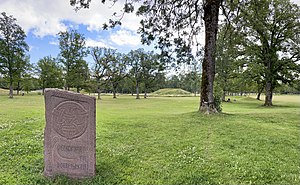Burial mound site in Norway

Borre mound cemetery (Norwegian: Borrehaugene from the Old Norse words borró and haugr meaning mound) forms part of the Borre National Park at Horten in Vestfold, Norway.
It is home to seven large and 21 smaller burial mounds. Excavations in the 1980s revealed that the oldest mounds date to 600 AD, i.e. prior to the Viking Age.
Background

The park covers 45 acres (182,000 m) and its collection of burial mounds is exceptional in Scandinavia. Today, seven large mounds and one cairn can be seen. At least two mounds and one cairn have been destroyed in modern times. There are also 25 smaller cairns and the cemetery may have been larger. Some of the monuments are over 45m in diameter and up to 6m high. Borrehaugene provides important historical knowledge and can be seen as evidence that there was a local power center from the Merovingian period to the Viking Age.
The first investigations of the cemetery took place in 1851–1852. Local road-builders used one of the mounds as a gravel-pit and in the process destroyed large parts of a richly equipped grave in a Viking ship. Antiquarian Nicolay Nicolaysen examined what was left of the mound. The grave contained weapons and riding equipment. The excavations uncovered an unusually good selection of craft work, much of which is on display at the Viking Ship Museum in Oslo.
This artistic craft work has become known as the Borre style and is today known for its beautiful animal and knot ornaments, which were often used for decorating harnesses. Some of the smaller cairns were investigated in 1925. They turned out to be simple cremation graves. More recent excavations were undertaken by archaeologist Bjørn Myhre in 1989 to 1991, both in and around the national park.
Midgard Viking Center

Midgard Viking Center (in Norwegian: Midgard vikingsenter, former known as Midgard Historical Center) at Borre was opened in 2000 and is part of the Vestfold Museum (Vestfoldmuseene). The center was established with the goal of spreading knowledge about the Viking Age. The center provides exhibitions and offers guided tours of Borre National Park.
Archaeological activities
In October 2007 ground-penetrating radar (GPR) measurements conducted by the archaeological prospection unit of the Swedish Central National Heritage Board on behalf of Vestfold County Administration led to the discovery of the buried remains of two pre-historic hall buildings, the first substantial building remains discovered in the vicinity of Borre.

In March 2013 a large-scale GPR survey conducted by the Ludwig Boltzmann Institute for Archaeological Prospection and Virtual Archaeology (LBI ArchPro) in collaboration with Vestfold County Administration and the Norwegian Institute for Cultural Heritage Research (NIKU) resulted in the discovery of another large hall building.
In 2015 Erich Draganits et al. suggested that a prehistoric harbour is likely to have been located at Borre based on the analysis of geomorphological features.
In March 2019 archaeologists found what is believed to be a buried Viking-era ship. Evidence so far points to it being a ship burial, typically constructed to serve as a tomb for high-ranking individuals.
References
- Nickel, Phyllis and Hans Jakob Valderhaug (2017). Norwegian Cruising Guide—Vol 2: Sweden, West Coast and Norway, Swedish Border to Bergen. Attainable Adventure Cruising Ltd. Page 86. ISBN 9780995893962.
- Borrehaugene (Store norske leksikon)
- "Borre Nasjonalpark". Kulturminnesok. Retrieved September 1, 2017.
- "Vestfold – tidligere fylke". February 16, 2021.
- Carver, M.O.H. (1992). The Age of Sutton Hoo: The Seventh Century in North-Western Europe. Boydell Press. Page 301. ISBN 9780851153612.
- Evensberget, Snorre (2018). DK Eyewitness Travel Guide Norway. Penguin. Page 125. ISBN 9781465478634.
- Norsk Reisehåndbok (1986). Norway Handbook 1986/87. Norsk reisehåndbok. Page 239. ISBN 9788274030022.
- Evensberget, Snorre (2014). DK Eyewitness Travel Guide: Norway. Penguin. Page 125. ISBN 9781465432469.
- "Midgard Historical Centre". Vestfoldmuseene. Retrieved September 1, 2017.
- Kongsgård funnet i Borre, 2007-12-05 Norwegian
- Fant Kongsgården på Borre, Aftenposten, 2007-12-05 Norwegian
- Sensasjonsfunn på Borre etter søk med snøscooter, Tønsberg Blad, 2013-05-24 Norwegian
- Hafen der Häuptlinge – Königreich der Toten, Press release LBI ArchPro German
- Draganits, E.; Doneus, M.; Gansum, T.; Gustavsen, L.; Nau, E.; Tonning, C.; Trinks, I.; Neubauer, W. (May 5, 2015). "The late Nordic Iron Age and Viking Age royal burial site of Borre in Norway: ALS- and GPR-based landscape reconstruction and harbour location at an uplifting coastal area". Quaternary International. Where Earth Scientists Meet Cleopatra: Geoarchaeology and Geoprospection of Ancient Landscapes. 367: 96–110. Bibcode:2015QuInt.367...96D. doi:10.1016/j.quaint.2014.04.045.
- Pruitt, Sarah (March 25, 2019). "Rare Viking Ship Lies Buried in Norway, Radar Suggests". HISTORY. A&E Television Network. Archived from the original on June 17, 2019. Retrieved June 18, 2019.
Other sources
- Forhistorien til nasjonalparken Norwegian
- Nasjonal Samlings bruk av nasjonalparken under andre verdenskrig Norwegian
External links
- Midgard Historical Center website
- Vestfoldmuseene website
- Kulturarv – Vestfold fylkeskommune
- Ludwig Boltzmann Institute for Archaeological Prospection and Virtual Archaeology
- Borre National Park
59°22′57″N 10°27′34″E / 59.38250°N 10.45944°E / 59.38250; 10.45944
Categories: